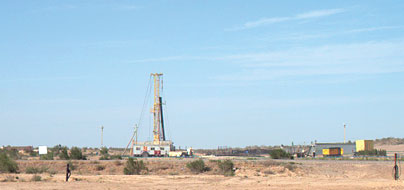To serve you better, our new website displays information specific to your location.
Please visit the site and bookmark it for future use.
In situ leaching or in situ recovery
In situ leaching (ISL), also known as in situ recovery, is a low capital-cost method of extracting uranium, copper or potash from suitable deposits. A suitable deposit is one where the commodity is located in saturated permeable horizons or distinctive geological areas that are bounded above and below by impermeable strata. Either acid or alkaline solutions can be used to dissolve the metal, depending on the chemical conditions present.
ISL is most commonly used in sandstone roll-front uranium deposits, though it can also be applied to paleochannel deposits and, potentially, to some calcrete hosted deposits as well. In Kazakhstan, the largest uranium producing country, the majority of the mines use ISL techniques with sulfuric acid to dissolve the uranium. Acid is also used in Russia and Australia, but due to higher carbonate content, alkaline sodium carbonate solutions are preferred for ores in the United States. The approach of ISL mining is broadly the same for both acid and alkaline leaching.
At the Khiagda project in Russia, where uranium is found in a series of paleochannels, SRK developed a reactive transport model coupling hydrogeological and geochemical capabilities to predict the dissolution of uranium with time. This model predicted flow paths and lixiviant or leaching streamlines from injection to recovery wells (see figure above) and used a popular software developed for the US Geological Survey computer program to evaluate the variability in uranium concentration, speciation and attenuation in the flow paths. The model was calibrated against actual field results, then used to evaluate the productivity of different well-field patterns. The results were used to define the production schedule for four paleochannels for the next ten years.
At the Zarechnoye project in Kazakhstan, SRK developed a 3D geological model to define not only the boundaries, thickness and grade of the roll-front deposits, but also the variation in disequilibrium. This helped to explain some of the variability in leaching rates, which would then assist with trials to improve efficiencies.
Vladimir Ugorets: vugorets@srk.com
Dmitry Yermakov: dyermakov@srk.ru.com

|
You can download a PDF of the entire |
PDF A4
|
PDF Letter
|
|
|
|
Our newsletters focus on specific areas of interest to earth resource professionals and clients. Each is available as an Adobe Acrobat PDF file. If you don't already have Adobe's PDF reader, you can download it free.


